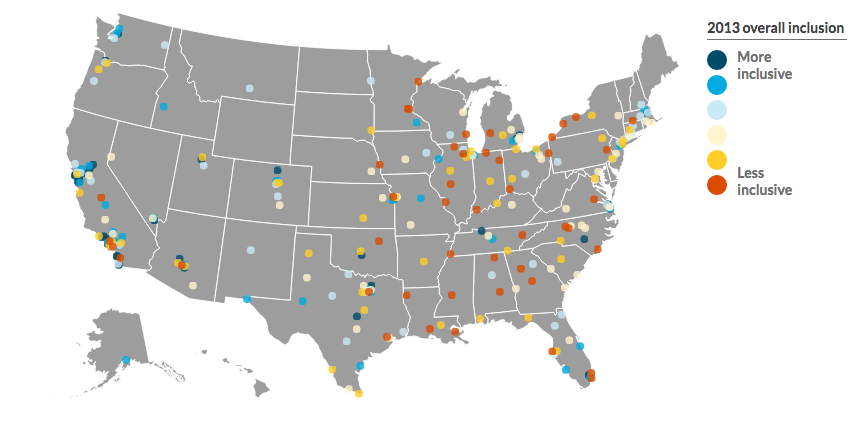While the increasing gaps between the coasts and the heartland continues to capture the media’s attention, a collection of recent research suggests that inequality within regions may be the greatest factor hampering economic growth. Five recent articles tell a nuanced story of how economic and racial inequities may impede regional economic development efforts. The research presented here from a variety of outlets examines the role of inequality in the overall economy of regions.
For example, research in the Journal of Regional Studies examines how the Great Recession challenged the economic resilience of metropolitan areas and how income inequality worsened these impacts. A separate analysis by the Urban Institute finds that economically healthy cities are more likely to be inclusive. In particular, older industrial cities struggle with issues stemming from inequality. Additionally, to complicate matters further, research from the Center for Economic and Policy Research finds inequality is likely worse than actually reported.
Economically healthy cities are more likely to be inclusive.
In Inclusive Recovery in US Cities, Urban Institute authors Erika Poethig, Solon Greene, Christina Stacy, Tanaya Srini, and Brandy Meixell examine the interaction between economic health and inclusion in U.S. cities over several decades. They define inclusive recoveries as those occurring “when a place overcomes economic distress in a way that provides the opportunity for all residents — especially historically excluded populations — to benefit from and contribute to economic prosperity.”
Based on a review of the literature, authors develop several indices to describe inclusion, which they combine into a measure of overall inclusion. As can be seen in the map below (and in this interactive version), many cities in what is colloquially known as the heartland struggle with overall inclusion. The authors find that economically healthy cities tend to be more inclusive than distressed cities, that smaller cities are more inclusive than larger ones, and that cities tend to improve on overall inclusion during periods of economic recovery.

Using case studies on Columbus, Louisville, Lowell, and Midland to supplement their analysis, the authors share lessons learned on inclusive recovery. Recommendations include adopting a shared vision, sustaining public leadership, recruiting partners across sectors, and leveraging assets and intrinsic advantages.
Income inequality worsened the impacts of the recession.
Surviving the Great Recession: the influence of income inequality in US urban counties was published last year but again appears in a recent issue of the Journal of Regional Studies. In an analysis of 639 urban counties and their economic performance from 2006 to 2010, authors Paul Lewin, Philip Watson, and Anna Brown of the University of Idaho find a statistically significant relationship between income inequality and the likelihood of entering the recession. Other factors positively associated with recession risk include dependence on proprietor income, a larger retired population, and more service sector employment. Evidence that suggests inequality undermines both resilience and economic growth implies that it is not just the presence of jobs in a region, but rather types of jobs, that matter, they find.
In particular, older industrial cities struggle with issues stemming from inequality.
A recent study by Brookings’ Alan Berube and Cecile Murray looks at “older industrial cities,” those urban counties with a city of more than 50,000 residents, a legacy reliance on manufacturing, and struggling with long-term economic transitions. Berube and Murray find high levels of both income and employment inequality by race in older industrial cities. Furthermore, levels of concentrated poverty and economic segregation are worse in older industrial cities. A previous Brookings analysis on income inequality found that older cities with fewer middle-class neighborhoods and larger amounts of subsidized housing generally tended to exhibit higher inequality.
In their book Coping with Adversity authors Harold Wolman, Howard Wial, Travis St. Clair, and Ned Hill offer a more expansive look at regional economic resilience. The authors find a complicated relationship between income inequality and resilience. Income inequality is positively and significantly associated with economic downturns, and in some instances, this inequality may hasten economic recoveries. However, while inequality appears to predispose a region to chronic distress, it may also be positively associated with recovery from these challenges. More information on Coping with Adversity can be found in last week’s Digest.
Income inequality is worse than reported.
An analysis by Dean Baker and David Rosnick of the Center for Economic and Policy Research, a left-leaning think-tank, finds that a recent report on family income by the Congressional Budget Office understates the rise of income inequality. The CBO analysis finds that income inequality in the United States appears to be less severe when the redistributive nature of means-tested transfers and federal taxes is applied. Baker and Rosnick suggest that efforts at redistribution compensate for only a small fraction of the broader trend of increasing income inequality.
They find that the growth in income at the top has been significantly faster than growth in income at the bottom and middle brackets, and that increased Medicare and Medicaid spending benefits incomes at the top more than the after-tax-and-transfer incomes of the bottom. The authors suggest that policy should focus more on before tax incomes to support more equitable economic growth.
Discussion
These results suggest an increased focus is being paid to the importance of inequality within regions, not just between them. As inequality continues to capture the attention of policymakers, more empirical research is needed to assess policies that address the issue and help increase economic opportunity for low-income families. Evaluating policies intended to reduce inequality through the lens of economic development, such as subsidies for quality childcare, supplementing the earned income tax credit, or raising the median wage, may offer additional insight beyond the case study approach utilized by most researchers.